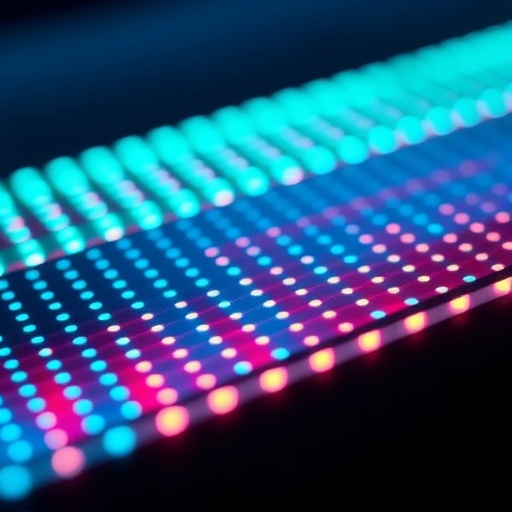
In the rapidly evolving landscape of optoelectronic devices, the quest for higher efficiency, improved directionality, and reduced power consumption remains an ongoing challenge. A groundbreaking development now emerges from the collaborative research led by Abdelkhalik, Garcia-Santiago, van Raaij, and their colleagues, who have unveiled a novel methodology to significantly enhance and control the electroluminescence characteristics of MicroLEDs through the integration of sophisticated metallic and dielectric metasurfaces. This advancement, detailed in their recent publication in Communications Engineering, heralds a transformative approach in MicroLED technology which could ripple across numerous applications, from advanced displays to highly efficient optical communications.
MicroLEDs have captivated researchers due to their extraordinary potential: they are miniature light-emitting diodes whose physical size lies in the micrometer scale, enabling superior brightness, contrast, and energy efficiency compared to conventional LEDs and OLED displays. However, harnessing the full potential of MicroLEDs requires overcoming intrinsic challenges associated with light extraction and emission directionality. Typically, a substantial portion of the light generated inside the device becomes trapped by internal reflections, leading to losses and limiting device efficiency. The new research confronts this bottleneck by leveraging carefully engineered metasurfaces—ultra-thin arrays of nano-structured elements tailored to manipulate electromagnetic waves.
The crux of this innovation lies in the application of metallic and dielectric metasurfaces directly integrated with MicroLEDs to facilitate enhanced light emission with meticulously controlled angular distribution. Metasurfaces act as finely tuned optical antennas, reshaping the local electromagnetic environment at the interface of the MicroLED emission surface. By designing these metastructures to support resonant modes and engineered phase gradients, the researchers succeeded in redirecting and intensifying the emitted photons in specific, desirable directions, thereby reducing scattering losses and dramatically improving the intensity perceived by an observer or optical system.
This approach distinguishes itself from traditional techniques that rely on macroscopic optical components or simple texturing of the LED surface, both of which suffer from limitations in scalability and effectiveness. Instead, the thin film nature of metasurfaces, coupled with their nanoscale patterning, allows for seamless integration onto MicroLED chips without adding significant bulk or complexity. This feature is particularly vital for applications such as augmented reality (AR), virtual reality (VR), and ultra-high-resolution displays where device thickness, weight, and form factor are at a premium.
Detailed experimental results showcased in the study demonstrate a marked improvement in electroluminescence intensity, with metallic metasurfaces offering superior enhancement compared to their dielectric counterparts due to their strong plasmonic resonances. However, dielectric metasurfaces, fabricated from high-index materials, exhibit advantages in lower optical losses and potentially better reliability, balancing performance and durability considerations depending on the application context. The research therefore opens pathways for tailored solutions by choosing appropriate metasurface materials and patterns to meet specific device requirements.
Furthermore, the precise control over emission directionality delivered by these metasurface-enhanced MicroLEDs stands to revolutionize optical system design. In conventional displays, light is radiated isotropically, demanding complex optics to collimate or guide illumination towards viewers. The new method inherently concentrates emission into narrow angular cones, enabling more efficient use of light and reducing power consumption. This feature could be a game-changer in portable electronics, wearables, and beacon systems for optical communication where signal fidelity and power budgets are critical.
The complex interplay of electromagnetic waves with the metasurfaces was elucidated through rigorous theoretical modeling and simulation, incorporating rigorous coupled wave analysis and finite-difference time-domain methods. These simulations informed the design parameters, such as periodicity, element shape, and material composition of the metasurfaces, enabling optimization of resonance wavelengths and far-field emission profiles. Such synergistic use of computational and experimental methods exemplifies the trend toward precision nanophotonic engineering.
Beyond direct performance enhancements, the research also addresses manufacturing considerations. The metasurfaces are fabricated using scalable lithographic techniques compatible with existing semiconductor manufacturing processes, suggesting readiness for incremental integration into commercial production lines. Additionally, the robustness of the metasurfaces against environmental factors like temperature variations and mechanical stress was evaluated, confirming their suitability for practical deployment.
The implications of this advancement extend to the burgeoning fields of 3D displays and spatially multiplexed optical systems. By engineering metasurfaces to dynamically manipulate emission patterns, future MicroLEDs could produce complex illumination profiles or enable holographic displays, pushing the boundaries of visual technologies. The ability to engineer surface electromagnetic responses at the nanoscale carries profound consequences for integrated photonics, where control over light–matter interaction is paramount.
Moreover, the environmental impact of energy consumption in display technologies is a growing concern. The enhanced efficiency achieved through metasurface integration can contribute substantially to lowering the carbon footprint of display manufacturing and usage. Enhanced directionality reduces wasted light and power, contributing to greener, more sustainable electronics.
This research is emblematic of the resurgence in nanophotonics where quantum and classical optical phenomena are harnessed via engineered structures smaller than the wavelength of light to provide functionality previously unattainable. Integrating such metasurfaces with MicroLEDs represents a synthesis of fundamental science and applied engineering, opening new horizons for smart lighting, optical sensing, and beyond.
The work from Abdelkhalik and colleagues is poised to stimulate further investigation into hybrid metasurface architectures, including tunable and active elements that respond to electrical or optical stimuli. Such dynamic control could enable real-time modulation of emission characteristics, unlocking new device paradigms such as adaptive lighting and beam steering in compact form factors.
Looking forward, the pathway carved out by this study paves the way for commercially viable MicroLED displays with unmatched brightness, efficiency, and angular control. As consumer demand for immersive visual experiences escalates alongside the proliferation of AR, VR, and smart devices, such innovations will be indispensable. Furthermore, these principles may translate into significant advancements in other optoelectronic devices, including photodetectors and lasers, reinforcing the broad technological relevance of metasurfaces.
In conclusion, the integration of metallic and dielectric metasurfaces with MicroLEDs to enhance and direct electroluminescence marks a pivotal breakthrough in nanoscale photonic engineering. This multidisciplinary effort synergizes materials science, nanofabrication, and optical physics to redefine the performance boundaries of light-emitting devices. As the research matures and transitions from laboratory demonstrations to industrial applications, it promises to catalyze a new era of luminous technologies characterized by unprecedented control and efficiency.
Subject of Research: Enhanced and directional electroluminescence in MicroLEDs via integration of metallic and dielectric metasurfaces.
Article Title: Enhanced and directional electroluminescence from MicroLEDs using metallic or dielectric metasurfaces.
Article References:
Abdelkhalik, M.S., Garcia-Santiago, X., van Raaij, TJ. et al. Enhanced and directional electroluminescence from MicroLEDs using metallic or dielectric metasurfaces. Commun Eng 4, 63 (2025). https://doi.org/10.1038/s44172-025-00401-w
Image Credits: AI Generated
Tags: Advanced display technologiesDirectional MicroLED technologyElectroluminescence enhancement methodsEnergy-efficient lighting solutionsFuture of optoelectronic devicesHigh-efficiency MicroLED applicationsInnovative semiconductor materialsMetasurfaces in optoelectronicsMiniature light-emitting diodesNano-structured elements for light manipulationoptical communication advancementsOvercoming light extraction challenges



